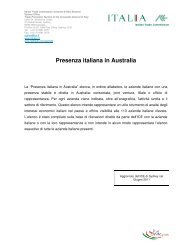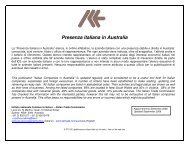Price Determination in the Australian Food Industry A Report
Price Determination in the Australian Food Industry A Report
Price Determination in the Australian Food Industry A Report
Create successful ePaper yourself
Turn your PDF publications into a flip-book with our unique Google optimized e-Paper software.
The amount represented by <strong>the</strong> retail sector reflects marg<strong>in</strong> and any costs <strong>the</strong>y have <strong>in</strong> centralised<br />
warehous<strong>in</strong>g and adm<strong>in</strong>istration. Marg<strong>in</strong>s for <strong>the</strong> retail sector are estimated to be 20 per cent of<br />
<strong>the</strong> wholesale price. In <strong>the</strong> wholesale sector, <strong>the</strong>re are marg<strong>in</strong>s for both <strong>the</strong> crusher and ref<strong>in</strong>er.<br />
The ref<strong>in</strong>er appears currently to be struggl<strong>in</strong>g to recover full overheads and any marg<strong>in</strong>. This is due<br />
to <strong>the</strong> competitive pressure from imports and <strong>the</strong> behaviour of retailers to ma<strong>in</strong>ta<strong>in</strong> <strong>the</strong>ir marg<strong>in</strong>s.<br />
A major driver of prices <strong>in</strong> <strong>the</strong> retail sector is <strong>the</strong> price of bottled oil from nearby Asian countries<br />
such as S<strong>in</strong>gapore. Products from <strong>the</strong>se markets are competitively priced <strong>in</strong> <strong>the</strong> <strong>Australian</strong> market<br />
and <strong>the</strong> retailers use this as a major <strong>in</strong>fluence on <strong>the</strong>ir buy<strong>in</strong>g price, ra<strong>the</strong>r than <strong>the</strong> cost of<br />
production with<strong>in</strong> <strong>the</strong> Australia market. The domestic ref<strong>in</strong><strong>in</strong>g <strong>in</strong>dustry has <strong>in</strong> <strong>the</strong> past successfully<br />
brought anti-dump<strong>in</strong>g action aga<strong>in</strong>st <strong>the</strong> imported product and currently has ano<strong>the</strong>r anti-dump<strong>in</strong>g<br />
application before <strong>the</strong> government.<br />
This has been accompanied by a steady <strong>in</strong>crease <strong>in</strong> share held by private labels to <strong>the</strong> po<strong>in</strong>t where<br />
<strong>the</strong>y now hold around 50 per cent of <strong>the</strong> market.<br />
Retail versus farmgate prices over time<br />
Figure 90. Retail and farmgate returns for margar<strong>in</strong>e,<br />
$ per tonne equivalent, quarterly 1997–2003<br />
$<br />
5,000<br />
4,500<br />
4,000<br />
3,500<br />
3,000<br />
2,500<br />
2,000<br />
branded margar<strong>in</strong>e<br />
margar<strong>in</strong>e (average)<br />
private label margar<strong>in</strong>e<br />
NSW farmgate<br />
Victoria farmgate<br />
1,500<br />
1,000<br />
500<br />
0<br />
July 1997 June 2003<br />
Source: <strong>Industry</strong> sources<br />
<strong>Price</strong> <strong>Determ<strong>in</strong>ation</strong> <strong>in</strong> <strong>the</strong> <strong>Australian</strong> <strong>Food</strong> <strong>Industry</strong> A <strong>Report</strong><br />
The farmgate numbers above are based on <strong>the</strong> delivered port price adjusted to a farmgate value.<br />
The graph shows that <strong>the</strong> movement <strong>in</strong> retail prices for branded product is <strong>in</strong>fluenced by a range of<br />
factors o<strong>the</strong>r than raw material prices. However, <strong>the</strong> farmgate price has more direct relativity to <strong>the</strong><br />
crusher prices and marg<strong>in</strong>s which are <strong>in</strong>fluenced by both meal and oil. The meal price is set by <strong>the</strong><br />
import parity price for soybean meal (canola meal trades at a discount to soybean meal due to its<br />
lower prote<strong>in</strong> value). In <strong>the</strong> case of oil, <strong>the</strong> value is between <strong>the</strong> import parity price for oil and <strong>the</strong><br />
export parity price for seed. The relative contribution of oil and meal to <strong>the</strong> crusher marg<strong>in</strong> varies<br />
between years and with<strong>in</strong> a year depend<strong>in</strong>g on <strong>the</strong> world oils and fats complex and <strong>the</strong> crop cycles<br />
<strong>in</strong> o<strong>the</strong>r parts of <strong>the</strong> world. Generally <strong>the</strong> crusher marg<strong>in</strong> will be higher earlier <strong>in</strong> <strong>the</strong> crop season<br />
and decl<strong>in</strong>e over <strong>the</strong> year.<br />
MARGARINE – ANALYSIS OF PRICING<br />
Retail pric<strong>in</strong>g<br />
Represented <strong>in</strong> Figure 91 is our analysis of <strong>the</strong> current share of <strong>the</strong> returns for each major sector<br />
engaged <strong>in</strong> <strong>the</strong> oils and fats value cha<strong>in</strong> as it relates to margar<strong>in</strong>e (note that <strong>the</strong> farmgate to<br />
wholesale component <strong>in</strong>cludes both primary and secondary process<strong>in</strong>g).<br />
84







